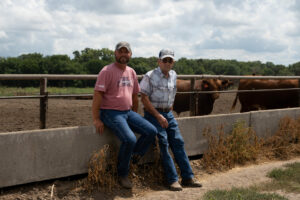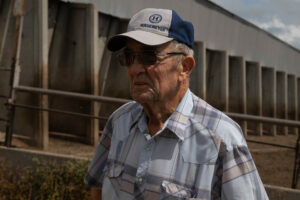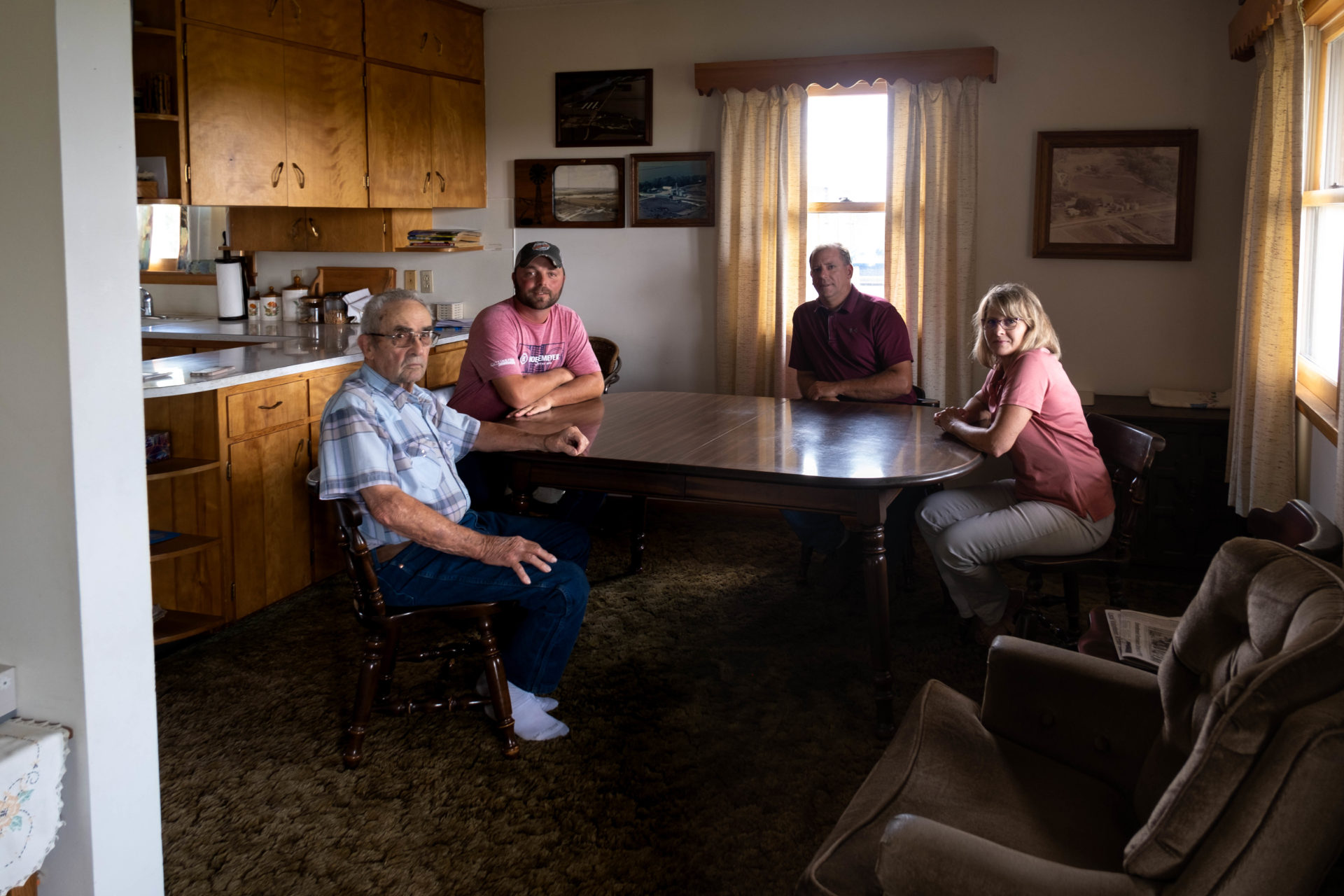Walking into Mr. Forbes house, it was easy to tell that he sticks to a routine. As any rancher, he’s up early in the morning for chores. He comes in for lunchtime and turns on NBC News. After lunch, he might doze off in his recliner, but he says he doesn’t have much time for naps. Although after 90 years on the ranch, we agree he’s earned one.
He was kind enough to let his bankers interrupt his rest time while he escapes the heat and eastern Nebraska humidity to chat with us.
Jim Forbes was one year old when his family began to bank with Points West Community Bank in Fullerton, Nebraska. It was 1932. During the Great Depression, over 9,000 banks failed or closed. The nearby bank in Palmer, Nebraska, the Forbes’ former banking institution, never reopened, leading the family to begin their partnership with Points West Community Bank.
Mr. Forbes’ grandson, Clay, works with him and joined us at the kitchen table. Clay farms 1400 acres, some of which he rents from Jim. The Forbes feed 2,300 head of cattle, mostly custom-fed, and Clay runs about 150 cow/calf pairs. Jim owns one part of the feedlot, while Clay owns the other part, and they manage it together. The pair each has a feed truck and split daily feeding chores.
The family started their cattle operation, specifically feeding cattle, in 1911. Prior to that, Jim’s grandfather worked for the butcher in Fullerton.
Jim was put to work at a young age, like any child of farmers or ranchers back in that day.
“I was raking with a team of horses before I was old enough to,” he laughed. “We would hay the hayfields in a threshing machine, and I’d haul the grain from the threshing machine to the elevator that we had out here. The elevator had a pit in it for dumping the grain. I couldn’t have been more than 11 years old and I’d hold the grain from the threshing machine, and we had what we called dump logs. The team of horses would stop right where the engine needed to be and I’d pull the lever. The logs dropped and the front wheels went up. And the grain all ran off right into the elevator. The elevator ran constantly. So I raked hay awfully young and hauled grain.”
Mr. Forbes joined the Navy for four years, and those were the only four years he was away from the ranch. His home base for those years was in Jacksonville, Florida.
“I went to Puerto Rico for three weeks, three times,” Jim said. “Nova Scotia once for three weeks, Iceland for six months and French Morocco for six months. We deployed constantly.”
Jim was never deployed during wartime, but he was in the Navy for the duration of the Cold War. His war stories were a little different from other war stories we hear.
“We patrolled every third day, and every 12th day we flew relays – we went so far out we couldn’t reach the base – and we did nothing in between,” Jim said. “We did nothing. Well, except to go to the gym to play basketball and watch a lot of movies in the evening.”
Jim’s father asked him to come back to the farm after his service in the Navy. Jim had a brother, who worked on the farm south of Palmer. He explained that he and his brother lived a different life. Jim drank very little, and kept his nose to the grindstone and his brother quit and moved to California.
“My dad died when he was 59 years old, of lung cancer,” Jim said. “I was needing him more at the time, I was 34 years old when he died, so it was too soon.”
Clay’s father passed away at 61 years old, leaving Clay with a lot of responsibility on the farm, which he’s taken over gracefully. Jim and his wife lost two daughters, both to a spinal disease similar to muscular dystrophy, one at 6 years old and one at 25.
A lot has changed in farming and feeding since Jim was young. He fed cattle with a scoop shovel, and then eventually they got feeders and he’d fill the feeders with a shovel every day or two. Jim recalls his father getting a 1937 model tractor.
“My father had a hired man that stayed until 1943 and he wanted to pick corn,” Jim said. “There was more money in it at the time, so he wanted to quit his job to pick corn for my dad. We then went a year or so without a corn picker. It was all dry land with a little bit of irrigation from the river. Not much irrigation in the cornfield but a little in alfalfa.”
“We flooded the alfalfa. But it was tough, two or three years of flooding and you’d lose your stand. But we flooded, with benches about 25 feet apart.”
Before the days of siphon tubes, they irrigated corn by burying pipe or lap boxes in the side of the ditch. Now, the operation has evolved past even siphon tubes, and Clay only remembers throwing them away.
“We could set siphon tubes about as fast as we could walk,” Jim laughed.
The Forbes got their first combine about a year before Jim’s father passed, in 1965. His father only operated it for one year. Jim’s been running it for 51 years.
“I’d run it [the combine] when they needed me, and they needed me every damn day it seems like,” Jim joked.
Clay motioned to the grain bin outside. At one time it fit all they had. Now it takes about an hour to fill. Back in the 60s, the Forbes farmed about 240 acres of corn, oats, wheat and alfalfa, just about all they needed to feed the cattle and hogs. They made the decision to forfeit their hog business.
Jim still helps wherever they need him, primarily with haying and harvest. He spends some of his days attending cattle sales. During the pandemic, even at 90 years old, Jim got pretty good at figuring out online bidding. He quit going to barns, and everywhere for that matter, for his safety and only recently started getting out again.
The Forbes get help from their five full-time employees, all of which have been with them long-term, with one at 28 years, one at 18 years, and the other three all at around six years.



